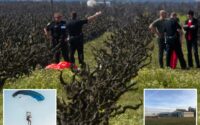Seattle kids forced to walk past junkies on their way to school
Drug-addled streets are becoming more commonplace in major liberal U.S. cities such as Los Angeles, Philadelphia and Portland.
In Seattle, scenes of addiction have spread to neighborhoods where children must walk to school every day.
Outside of Summit Sierra High School, a top charter school in the city, footage shows students walking past addicts shooting up on streets littered with drug paraphernalia.
“It really is living through America’s slums here in Seattle,” Discovery Institute journalist Jonathan Choe told “Jesse Watters Primetime” Thursday.
“And this is the heart of the Chinatown International District, an area that’s already been marginalized, that already faces so many problems, homeless encampments, drug dens, drug users, and the criminal activity that just comes along with all of this stuff,” he said.
Choe acknowledged Seattle Mayor Bruce Harrell’s continued effort to keep “talking” about and “prioritizing” that neighborhood. However, even with the increased patrol and officers surveilling the streets, Choe argued these additional measures are “just not working” and are not leading to lasting change in the community.



“There is no clear blueprint,” Choe said on finding a solution. “In fact, the mayor even said during a State of the City address this past week that he’s going to do something about it eventually. But we don’t know all the details right now. And that’s the most frustrating piece on the ground. There’s no exact timeline or a strategy and plan.”
Choe said after seeing the video the mayor should have organized a massive cleanup for the area around the school where addicts were shooting up.
“He’s feeling a lot of political pressure and heat there is no doubt because this isn’t the only school,” explained Choe, saying that other neighborhoods in Seattle are suffering from the same rampant drug abuse outside their schools.
“The John Stanford International School in Seattle’s Wallingford neighborhood, that’s also dealing with a massive encampment that just has been left to linger,” Choe said.
Choe explained how the mayor had attempted to clear out the neighborhood several times, but the “vicious cycle” keeps making its return.
“The criminal activity, the drug dens, the homelessness, the enforcement isn’t there. Nobody is being arrested or prosecuted. And even if they are arrested and prosecuted, the judges let them out,” he said.


